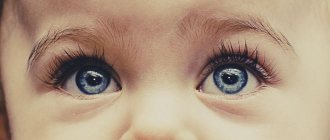Causes
If bags under the eyes appear in a newborn, this may be due to many reasons:
- Swelling. It often occurs in infants immediately after birth and usually goes away within a few weeks. Swelling is due to the fact that the child was in the womb for a long time, where all external tissues were immersed in amniotic fluid.
- Increased sensitivity of the skin around the eyes. This means that any exposure to a negative factor causes a reaction on the eyelids. The condition can also manifest itself in a rash, redness, itching, burning and other unpleasant symptoms.
- Rhesus conflict between mother and fetus. It is formed only if the mother is Rh positive and the child is Rh negative. This means that the woman’s immune system perceives the fetus as a foreign agent, and therefore secretes antigens against it. With modern therapy, pregnancy can be maintained, but the negative reaction of the immune system affects the fetus.
- Endocrine disorders. This condition is often observed with thyroid pathology. This affects the child’s appearance; he becomes swollen, especially in the eye area.
- Allergic reactions. They can be formed by the action of household allergens, for example, dust, animal hair. Or when the mother consumes foods that negatively affect the health of the baby during breastfeeding.
- Increased intracranial pressure. This is a neurological disorder that is accompanied by headaches, swelling of the facial tissues, which causes the baby to become restless.
- Kidney pathologies. When the urinary system is disrupted, fluid is retained in the body and therefore distributed among tissues and organs. Swelling appears not only on the face, but also on the limbs.
- Infectious and viral diseases that weaken the entire body. The condition is aggravated if the pathogen enters the eye tissue. Swelling, inflammation, redness and other pathological symptoms form. If an infection gets into the eyes, the condition is accompanied by suppuration of the inner corner.
Each cause has its own treatment, so the doctor needs to classify the disease and determine the exact cause.
Local edema
However, the occurrence of local edema in infants is influenced by many factors, among which are:
- genetic predisposition, structural features of the organs of vision (transparent skin through which the capillary network is visible, creating the effect of dark circles);
- lack of sleep, overwork;
- excessive consumption of salty foods (salt can retain water in the body);
- penetration of a foreign object into the eyes.
Bags around the eyes can cause various pathologies:
- diseases of the kidneys and urogenital tract;
- heart diseases;
- vegetative-vascular dystonia;
- low hemoglobin in the blood;
- metabolic disorder;
- helminthiasis;
- increased intracranial pressure;
- runny nose;
- conjunctivitis;
- ARVI;
- sinusitis, inflammation in the sinuses, congestion, etc.;
- dysfunction of the lacrimal ducts;
- allergic reactions. In this case, swelling forms suddenly, the eyes become red, increased lacrimation and nasal discharge are observed.
Symptoms
In addition to severe swelling of the skin around the eyeballs, infants may experience additional symptoms:
- redness of the tissue on the eyelids or the eyeball itself;
- severe swelling that can completely cover the eyeball;
- discomfort in the eyes: itching, burning, pain, sensation of a foreign body that is not actually there;
- discharge of purulent contents from the eyes, which sticks the eyelashes together in the morning (with a bacterial cause of edema);
- general malaise - the child becomes whiny, irritable, cries for any reason;
- additional allergic reaction in the form of redness, peeling, itching, burning, rash.
If any of the above symptoms occur, it is recommended to consult a doctor. This will prevent the risk of many complications for the eyes and the whole body.
Diagnostics
To determine the patient's health status, the doctor performs several diagnostic tests:
- Interview with the child's parents. They may complain about disturbing symptoms and tell what diseases the mother had during pregnancy.
- General inspection. With its help, you can detect purulent discharge due to the action of bacteria, a foreign body in the eyes, allergic manifestations and many other signs.
- Bacteriological culture. With its help, the pathogens that cause the disease are detected, as well as the antibiotic to which it is sensitive.
- Serological study. This is a method to determine the viral nature of the disease.
- General clinical analysis of blood and urine, blood biochemistry. Based on these tests, cellular levels in various human biological fluids can be determined. The doctor may suspect the disease depending on the deviation from normal urine and blood parameters.
- Allergy test. It is carried out in the autumn-winter period, when the child is completely free of any types of allergies. Various groups of antigens are sequentially applied to the child’s wrist. If redness or inflammation appears in any part of the hand, this indicates an allergic reaction to the substance applied by the doctor.
Based on diagnostic tests, the doctor can make a reliable diagnosis, only then treatment begins.
Regulating your baby's drinking regime
If your baby has swelling in the eyes and other areas of the body, the doctor may advise you to stay hydrated. Typically, the amount of fluid consumed is calculated at the rate of 50 ml of water for every kilogram of the child’s body. This is the daily norm.
It is important for parents to remember that during edema, it is impossible to sharply limit the baby’s drinking. This can lead to dehydration and increased body temperature. The child should definitely be given water, but you can limit the amount.
External features
Goliath fish (or large tiger fish) grows up to one hundred and eighty centimeters in length and reaches a weight of fifty kilograms. The predator has sixteen teeth, very reminiscent of powerful fangs. With their help, the tiger fish (goliath) literally tears apart its prey. It is endowed with a huge mouth, and an elongated powerful body with small pointed fins is covered with large silver scales, which sometimes have a golden tint. The lifespan of a monster is about fifteen years. Males are usually noticeably larger than females.
The Goliath tiger fish is one of the most feared fish on the planet. Its appearance suggests that this is a ferocious and formidable predator with aggressive behavior. Externally, this fish has some similarities with another underwater predator - the piranha, which, fortunately, does not grow to such a terrifying size.
Despite its not the most attractive appearance, the Goliath tiger fish often becomes the subject of sport fishing; it is kept in zoos and exhibition aquariums in which a constant water temperature (not lower than +23 °C) is maintained with powerful filtration. This fish is unpretentious in keeping.
Interestingly, the water dog is a lungfish, unlike most species. She tolerates the complete absence of oxygen quite calmly. During dry seasons, it buries itself in mud holes and completely envelops its body in mud. These creatures can adapt to almost any conditions with amazing efficiency. Some representatives even live in trees that have fallen into the water.
Komarovsky about bags under the eyes of infants
In his program, Dr. Komarovsky talks about bags under the eyes of babies. He says that this phenomenon occurs in all children immediately after birth. The swelling should gradually decrease, and 2 weeks after birth it will completely disappear.
If swelling persists after this time, you should consult a pediatrician and specialist doctors. Perhaps the symptom is caused by a disease of the internal organs. If it is detected early and treatment is started, in most cases the prognosis will be favorable.
If there is prolonged swelling, you should adhere to the drinking regime for infants. If the baby is only breastfed, the amount of milk consumed is not limited. This is because it is not considered a liquid as it curdles inside the baby's stomach.
Anatomy of the eye: structure and functions
Vision is one of the most important mechanisms in a person’s perception of the surrounding world. With the help of visual assessment, a person receives about 90% of information coming from outside. Of course, with insufficient or completely absent vision, the body adapts, partially compensating for the loss with the help of other senses: hearing, smell and touch. However, none of them is able to fill the gap that occurs when there is a lack of visual analysis.
How does the most complex optical system of the human eye work? What is the visual assessment mechanism based on and what stages does it include? What happens to the eye when vision is lost? This review article will help you understand these issues.
Prevention
If puffiness and bags under the eyes are caused by physiological factors, it is impossible to prevent them. All babies experience swelling around the eyes immediately after birth. To prevent pathological factors, parents should use the following rules:
- maintaining a drinking regime, using water for the baby only when necessary;
- a healthy lifestyle for the mother during pregnancy, no use of harmful, toxic substances, illegal drugs;
- compliance with all hygiene rules when caring for a baby, for example, daily cleaning of the bathtub before bathing, maintaining cleanliness and order in the crib;
- timely treatment of all systemic diseases;
- timely visits to doctors of a narrow specialty to prevent the development of ophthalmological pathologies and other diseases;
- modern therapy of local diseases in the eye area.
The presence of bags under the eyes of a newborn does not always indicate a pathological condition of the body. To make a diagnosis, additional symptoms are needed that parents can warn about or that are detected during examination. If bags under the eyes are caused by an ophthalmological disease, it is necessary to carry out complex therapy so as not to cause a risk of relapse.











